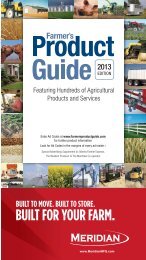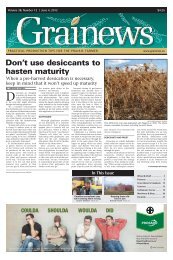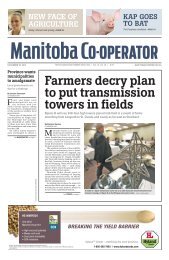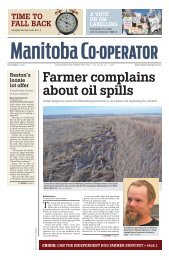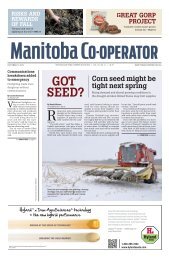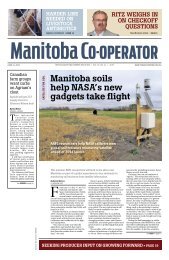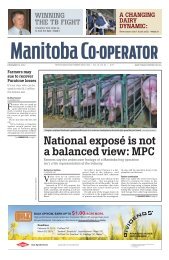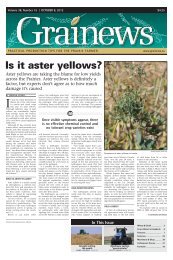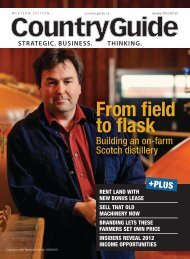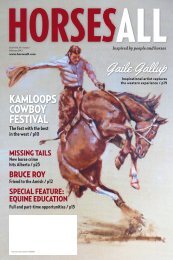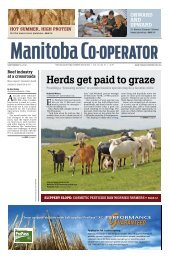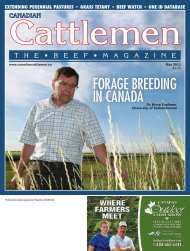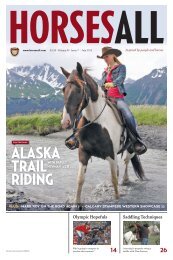Create successful ePaper yourself
Turn your PDF publications into a flip-book with our unique Google optimized e-Paper software.
30 The Manitoba Co-operator | July 12, 2012<br />
COLUMN<br />
A healthy back is an indication of a sound horse<br />
A horse’s spine is just not sufficiently developed to<br />
withstand heavy weight bearing until it is fully mature.<br />
Carol Shwetz, DVM<br />
Horse Health<br />
Horses were not naturally<br />
created to bear the weight<br />
of a rider, so conscious<br />
effort needs to be taken to develop<br />
and condition a horse’s back. This<br />
conditioning will then allow it<br />
to successfully and comfortably<br />
carry a rider without sustaining<br />
long-term damage.<br />
Seen from the side, the horse’s<br />
top line begins from the poll and<br />
ends at the base of the tail. A<br />
healthy top line is even, smooth,<br />
and continuous with no breaks,<br />
unnatural kinks, peaks, valleys,<br />
or indentations in front of<br />
or behind the withers. There is<br />
a tendency to roundness, and<br />
when seen from above healthy<br />
backs are symmetrical with<br />
smoothly contouring muscling<br />
mirroring one another on either<br />
side of the spine.<br />
The horse must develop the<br />
correct muscles which properly<br />
engage his back and hindquarters.<br />
Horses with poor carriage,<br />
such as hollow backs or inverted<br />
frames, place themselves in anatomical<br />
and bio-mechanical<br />
disadvantaged positions with farreaching<br />
consequences. Damage<br />
befalls not only the back itself,<br />
but over time hocks, front heels,<br />
dental arcades, and soft tissues<br />
throughout the body are also<br />
affected .<br />
Growth plates in the back of a<br />
horse do not fuse until the horse<br />
is five to six years of age, so when<br />
weighted prematurely the responsibility<br />
for supporting the weight<br />
of a rider is placed upon the connecting<br />
musculature of the back.<br />
“Every day I get to walk outside<br />
and see what we’re building.<br />
We can see<br />
our future<br />
when we step out our front door.”<br />
It’s time to tell the real story<br />
Unnatural strain sets the stage for<br />
hollow backs or inverted/upsidedown<br />
horses.<br />
Although young horses cope<br />
with physical weight bearing, they<br />
fail to flourish and fail to remain<br />
sound into their teen years. The<br />
horse’s spine is just not sufficiently<br />
developed to withstand heavy<br />
weight bearing until it is fully<br />
mature. Unfortunately for the<br />
horse, it looks mature far before<br />
they are mature.<br />
A properly prepared riding<br />
horse understands how to carry<br />
himself. He must learn to coil his<br />
pelvis, step deeply underneath his<br />
mass with his hind legs, stretch<br />
his back, and telescope his neck.<br />
Once properly ground schooled<br />
he can learn to carry this feeling<br />
through while carrying the<br />
Canadian agriculture is a modern, vibrant and diverse industry, filled with forward-thinking people who<br />
love what they do. But for our industry to reach its full potential this has to be better understood by the<br />
general public and, most importantly, by our industry itself.<br />
The story of Canadian agriculture is one of success, promise, challenge and determination. And the<br />
greatest storytellers are the 2.2 million Canadians who live it every day.<br />
Be proud. Champion our industry.<br />
– Jason Rider, Ontario<br />
Share your story, hear others and<br />
learn more at AgricultureMoreThanEver.ca<br />
Saddles are a bit like<br />
shoes. When they<br />
do not fit they can<br />
be uncomfortable<br />
or painful, causing<br />
other physical<br />
problems as well. Horses with poor carriage, such as hollow backs or inverted frames, place<br />
themselves in anatomical and bio-mechanical disadvantaged positions with<br />
far-reaching consequences.<br />
POWERED BY FArM CrEdIT CAnAdA<br />
05/12-18723-1E C<br />
18723_1E_C Boots 8.125x10.indd 1 5/<strong>17</strong>/12 7:28 AM<br />
weight of a rider upon his back.<br />
Once schooling begins, development<br />
of a horse’s back takes time,<br />
a long time. It takes a year at least<br />
to establish a strong top line in a<br />
horse.<br />
All tack used upon a horse<br />
effects his movement. The type<br />
of bit and nature of its use in<br />
the rider’s hands impacts how<br />
the horse carries his head, and<br />
so has the ability to shape the<br />
horse’s entire body and manner<br />
of movement.<br />
Saddle fit<br />
Saddle fit is critical to healthy<br />
movement of a horse’s back. A<br />
rider sits on layers of living tissue<br />
nourished by blood circulation.<br />
Saddle pressure drives blood circulation<br />
out of tissues, depriving<br />
them of nourishment. The tiny<br />
nerves that pass out of the spinal<br />
column innervating the back<br />
muscles are damaged greatly with<br />
unforgiving pressure. The muscles<br />
of the equine back are activated<br />
by electrical impulses which reach<br />
the individual cells through this<br />
network of tiny nerves. Without<br />
electrical impulses the muscles of<br />
the back wither, waste and sink<br />
away from the spine, leaving a<br />
weak back. Over time the horse<br />
loses its healthy top line, developing<br />
deep holes behind the withers.<br />
Healthy backs feel warm, soft,<br />
and supple. They are quiet and<br />
resilient. Signs of early damage<br />
to a horse’s back include heat<br />
bumps, uneven sweat patterns,<br />
and flickering and flinching upon<br />
touch once the saddle is removed.<br />
Over time white patches of hair<br />
along the back are testimony<br />
to damaged tissues as pressure<br />
harms the hair follicles, resulting<br />
in a visible scar. Most often these<br />
white patches are partnered with<br />
the visible hollowing of top-line<br />
musculature.<br />
Saddles are a bit like shoes.<br />
When they do not fit they can be<br />
uncomfortable or painful, causing<br />
other physical problems as well.<br />
So, when saddles are not a good<br />
fit horses will communicate such<br />
with unhappy body language,<br />
often increasing volume with<br />
increasing discomfort.<br />
Signs of pain caused by ill saddle<br />
fit include, but are not limited<br />
to, resistance to touch, pinning<br />
ears, head tossing, lack of focus,<br />
spooking, swishing or wringing<br />
tail, grinding teeth, stiffness,<br />
reluctance to stride out, unusual<br />
posturing, lameness, cold-backed<br />
behavior, rearing and bucking.<br />
No amount of training or discipline<br />
will ever overcome pain.<br />
Adaptations for the pain under<br />
saddle can create habitually poor<br />
patterns of movement that may<br />
remain long after the saddle as<br />
been removed.<br />
Carol Shwetz is a veterinarian<br />
specializing in equine practice at<br />
Westlock, Alta.



